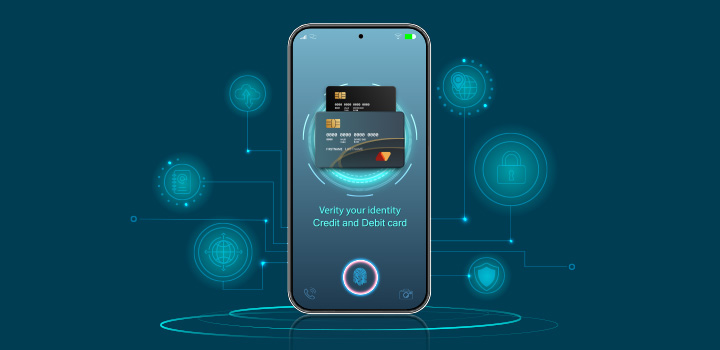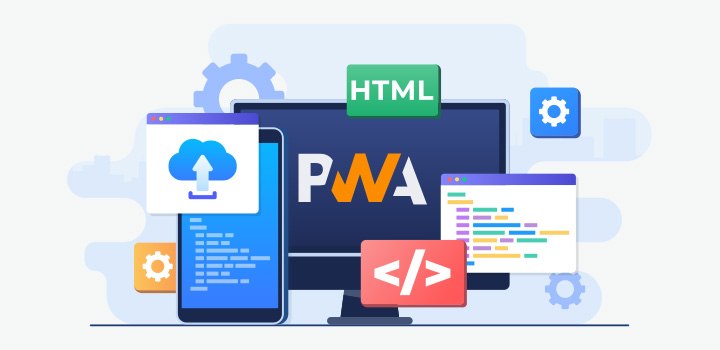

Arvind Kant
Ionic Framework - the Hybrid Framework for Everything You Need
As mobile devices become ever-present, businesses need a cost-effective way to create engaging applications for diverse platforms. Ionic, a robust open-source framework, steps up to the challenge. Ionic allows developers to build high-performance mobile, desktop, and progressive web apps (PWAs) by leveraging familiar web technologies like HTML, CSS, and JavaScript. This translates to faster development cycles, reduced costs, and stunning user interfaces across platforms.
What is an Ionic Framework?
Ionic framework is an open-source toolkit that lets you build mobile desktop, and even progressive web apps (PWAs) using familiar web technologies like HTML, CSS, and JavaScript. Below are some essential things to know about Ionic:
Cross-platform development
With Ionic, you can write your app’s code once and then deploy it to multiple platforms, like iOS, Android, and the web, saving you time and effort.
Web technologies
Ionic builds on top of web technologies, so if you’re already familiar with HTML, CSS, and JavaScript, you’ll have a head start with Ionic.
UI components
Ionic provides a standard collection of pre-built UI components, including sliders, menus, buttons, and more. This streamlines the development process, allowing you to create visually stunning and functional mobile apps.
Integrations
Ionic integrates well with popular JavaScript frameworks like Angular, React, and Vue.js, allowing you to leverage their features and functionalities within your Ionic app.
Overall, Ionic is a powerful tool for developers who want to build high-quality apps without learning native programming languages for each platform.
Top 10 Features of Ionic Framework
| 1 | Cross-platform |
| 2 | Based on Web Standards |
| 3 | Helps in Creating Beautiful Design |
| 4 | Cordova Plugin |
| 5 | License |
| 6 | Ionic CLI |
| 7 | Framework Compatibility |
| 8 | JavaScript Components |
| 9 | Angular, React & vue.js |
| 10 | Cost Effective |
Official site: https://ionicframework.com/
Why Ionic Framework
Reasons to Switch to the Ionic Framework
- The developer can use the framework completely free
- Ionic is built on Angular.
- Ionic follows material design for Android, so it feels like a Native.
- Ionic has a beautiful default UI that is easy to customize tools and services.
- Ionic Integrates Easily with Native Functionality
- The Core Development Team Is Awesome
- The community is active and awesome
- Ionic supports major technology like react, vue & angular
- Ionic is mainly based on angular and angular is supported by Google, which means there is a long-term support available
- Ionic is based on web technology
Pros and cons of using the Ionic framework deliver a complete overview for developers.
Advantages
Simple to Learn
Developers with a basic understanding of CSS, HTML, or JavaScript frameworks can quickly learn and start developing with Ionic. This simplicity also facilitates conversion to Ionic when hybrid app development is necessary.
Well-Organized Documentation
Ionic boasts excellent and well-organized documentation, making it easier for developers to find the necessary information.
Cross-Platform Compatibility
Ionic allows applications to run seamlessly on various platforms, including native iOS, Android, desktop, and the web, all from a single codebase. This “write once, run anywhere” method is a substantial benefit.
Customizable User Interface
Ionic’s user interface is highly customizable, with themes and components that adapt to their running platform.
Built Using Angular
Leveraging AngularJS provides developers with a robust framework, making code more understandable and offering a solid structure.
Disadvantages
Performance
Ionic apps are slower than native apps developed precisely for one platform (Android or iOS). This difference might be negligible for most users, but it’s important to consider applications where speed is essential.
Security Concerns
Ionic apps may not offer the same level of security as native apps, making them less suitable for applications handling sensitive information, such as financial apps.
Limited Native Functionality
The Ionic framework may not fully support some native functionalities, requiring developers to create custom plugins.
Not Suitable for Graphic-Intensive Apps
The Ionic framework might be better-suited for applications or games with complex graphics.
Expertise Required
Developing with Ionic requires knowledge of JavaScript and advanced libraries and technologies like Angular, Cordova, and Ionic.
Risk of Being an Early Adopter
As Ionic technology evolves, there is a risk of changes in support, standards, and libraries, may occur, potentially requiring developers to adapt to updates or redesigns.
This balanced assessment can help developers make informed decisions based on their project requirements and priorities.
Ionic and AI
Artificial Intelligence (AI) encompasses various technologies and methodologies to create systems capable of performing tasks requiring human intelligence. Machine Learning (ML) and Deep Learning (DL) are subsets of AI that have significantly transformed app development. These technologies enable applications to learn from data, recognize patterns, and make decisions, enhancing functionality and user experience.
Combining Ionic with AI unlocks a new frontier of intelligent app development. Ionic’s pre-built components act as a springboard, empowering you to craft intuitive and visually captivating experiences, while AI injects intelligence and automation, maximizing the app’s potential.
We can utilize AI in multiple areas like:
Personalized Recommendations
One critical case of AI is giving recommendations with personalized information. It proceeds with the data by analyzing and observing data patterns. Personalization is essential for end users.
Chatbots for Customer Support
Having AI-powered chatbots in your Ionic app for customer support is advantageous. These chatbots can handle various tasks, such as providing product information, helping with account management, answering FAQs, and even resolving fundamental problems. These services are always available, providing users with immediate responses 24/7. By understanding user queries through natural language processing and machine learning, these chatbots can provide relevant and accurate information, thereby enhancing user satisfaction and engagement with your app.

Natural Language Processing (NLP)and
Voice recognition and Natural Language Processing (NLP) capabilities enable users to interact with your application using natural language. This functionality proves particularly valuable in applications such as virtual assistants, language learning platforms, and transcription services. These technologies empower users to communicate naturally with the app, enhancing user experience and accessibility.
Image Recognition
AI-powered image recognition can enable your app to identify objects, faces, and emotions from images. It is especially valuable for social media, e-commerce, and health monitoring applications.

Predictive Analytics
AI-driven predictive analytics can help your app anticipate user requirements. For instance, an e-commerce app, can predict which products a user will likely to buy next based on their previous behavior.

The combination of Ionic and Artificial Intelligence has expanded the potential for developing engaging, highly personalized, intelligent mobile apps. This affiliation allows for enhanced user experiences through features like personalized recommendations, natural language processing, and predictive analytics. Ultimately, it enables developers to create apps that anticipate and meet users’ individual needs more effectively than ever before.
As we embark on our journey to integrate AI into our Ionic apps, we must stay updated with the latest advancements in AI and mobile app development. Experiment, iterate, and keep user experience at the forefront of your efforts.
Ionic with AI framework
Alan AI (https://alan.app)
Alan AI leverages advanced generative AI to enhance productivity, streamline operations, and expedite onboarding processes. It enables you to seamlessly integrate multimodal conversational experiences into your app without additional overhead.
As an end-to-end conversational AI platform, Alan AI simplifies the development of robust AI assistants and chatbots. Its backend handles complex tasks like creating spoken language models, training speech recognition software, and deploying conversational components. With Alan AI, you can create engaging conversational interfaces using just one developer, eliminating the need for extensive Machine Learning and DevOps expertise.
By leveraging JavaScript for dialog scripts, Alan AI offers high customization and adaptability, allowing you to enhance user interactions beyond traditional touch interfaces for any workflow or function in your app.
Learn more by clicking this video link and going to official sites
Ionic + Kapa.ai
Integrating Kapa.ai with Ionic allows developers to enhance mobile applications with advanced AI capabilities. To begin, developers should set up an Ionic project using the Ionic CLI, creating a blank or starter template. Next, the Kapa.ai SDK is integrated into the project through npm installation, and initialization using the provided authentication credentials. This initialization process typically involves configuring the SDK and initializing necessary services within the Ionic app.
Once integrated, developers can leverage Kapa.ai’s AI functionalities, such as natural language processing (NLP), image recognition, and chatbots. For instance, developers can implement chatbots to handle user queries or integrate image recognition for enhanced user interactions. UI components in the Ionic app are designed to seamlessly interact with these AI features, incorporating input fields for user interactions and displaying AI-generated content.
After ensuring the app functions across platforms and devices through thorough testing, we can deploy it to app stores or distribute it through other channels.. Attention to security and performance optimizations ensures a smooth integration, providing users with a sophisticated and interactive mobile experience powered by Kapa.ai’s advanced AI capabilities.
Ionic + BlinkCard
Ionic + BlinkCard refers to integrating the BlinkCard SDK into Ionic applications. BlinkCard is a powerful tool for scanning and processing identity documents such as driver’s licenses, passports, and ID cards using a mobile device’s camera. Integrating BlinkCard into an Ionic app allows developers to quickly add secure and accurate document scanning capabilities, enhancing user experience and app functionality, especially in applications requiring identity verification or document scanning features-card-not-present fraud by up to 95%.

Website: https://microblink.com/
Ionic with Augmented Framework
AR.js
AR.js is a framework used for developing Augmented Reality (AR) applications on the web, eliminating the need for traditional mobile app development efforts and costs associated with app stores (such as validation and publishing time). It influences technologies like HTML, CSS, and JavaScript, which are well-known among designers and developers. This approach enables developers to create AR experiences that can be accessed directly through a web browser, making AR more accessible and easier to deploy across different platforms without requiring users to install a dedicated mobile app.
You can find more detailed information and documentation about AR.js on their official site: AR.js Official Documentation.
Ionic with Augmented Reality/ Virtual Reality
AR also known as augmented reality is a technology where you can see digital things in real life using your mobile camera. AR has become very famous for displaying objects, showcasing products on e-commerce, architecture, and many more.
In iOS and Android, there are many apps you can test but how about implementation on our app and if it is on an ionic framework
Let’s break down augmented reality (AR) in simple terms:
Augmented Reality (AR):
- Imagine you’re wearing special glasses or using a smartphone app. Looking around, you still see the real world—the room you’re in, people, furniture, and everything else.
- But here’s the cool part: AR adds extra stuff to what you see! These extras are computer-generated objects, like virtual characters, information, or animations.
- So, it’s like having magical glasses that show you hidden things in your natural surroundings.
Difference Between AR and Virtual Reality (VR):
- In AR, the real world is your main stage, and the computer-generated objects are like actors who join the scene.
- In VR, you put on a headset, and suddenly, you’re inside a completely different world.

Use Cases for Augmented Reality
Try Before You Buy
Imagine shopping for furniture. With AR, you can see how that new sofa would look in your living room before buying it. No surprises!
Navigation
AR can guide you through a city by overlaying arrows on the streets or showing you where the nearest coffee shop is.
Education
AR can make learning fun! Imagine studying biology and seeing 3D models of cells right in your textbook.
Gaming
Pokémon GO is a famous example. It mixes the real world with virtual Pokémon creatures you can catch.
So, AR is like a magical blend of reality and imagination
AR/VR App we can implement
- AR/VR for Healthcare
- AR/VR for Education
- AR/VR for Fitness
- AR/VR for Tourism
- AR/VR for Entertainment
- AR/VR For Retail
AR/VR Use Cases in Healthcare
AR for 3D Body Mapping
Augmented Reality (AR) is used for precise 3D body mapping. By superimposing digital objects onto the real-world environment, AR enhances medical procedures.
AR for Maintenance in Medical Labs
AR is used for maintaining tasks in medical laboratories. Technicians can use AR-equipped devices (such as smartphones or tablets) to overlay digital information on lab equipment, aiding in diagnostics and repairs.
VR for Mental Health Treatment
VR is particularly effective in treating nervous system disorders and anxiety. For example, patients facing brain surgery can take a virtual trip inside their brain using VR. A 3D model of the brain, based on MRI and CT scans, helps patients understand their condition and the surgical process, reducing anxiety and increasing awareness.
VR for Pain Management
VR can be used to manage pain. Immersing patients in a virtual environment, it distracts them from physical discomfort. This distraction technique has been successful in various scenarios, such as during wound care or labor pain.
AR/VR Use Cases in Education
Augmented Reality (AR) and Virtual Reality (VR) have immense potential in transforming education. Let’s explore some real-life use cases where AR and VR enhance learning experiences.
Historical Site Tours
Students can dive deep into ancient history by taking virtual site tours. These tours allow them to explore historical landmarks, ancient cities, and archaeological sites without leaving the classroom.
Astronomy and Space Exploration
Students can journey through space using VR. They can explore planets, moons, and distant galaxies, gaining insights into celestial bodies and astronomical phenomena.
Human Anatomy Visualization
AR-enhanced visuals allow students to explore the human body. They can view 3D models of organs, systems, and tissues, gaining a better understanding of anatomy and physiology.
Geography and Geology Exploration
AR allows students to explore geographical features, like mountains, rivers, and ecosystems. They can visualize tectonic movements and geological formations.
Architectural Design and Engineering Simulations
VR enables students to design and explore architectural structures. They can create 3D models, simulate building processes, and experience architectural spaces.
AR/VR Use Cases in Fitness
Interactive Fitness Classes
AR and VR enable interactive group fitness classes. Users can join virtual sessions led by trainers, follow choreographed routines, and receive real-time feedback.
Fitness Challenges and Games
AR fitness apps can turn exercise into a game. Users compete in virtual challenges, collect rewards, and unlock achievements while working out.
Form and Posture Correction
AR Smart clothing with movement tracking can help users improve their exercise form visual cues overlay the user’s body, guiding them to maintain proper posture.
Outdoor Adventure Simulations
VR can simulate outdoor adventures like hiking, rock climbing, or kayaking. Users experience the thrill of these activities within a controlled environment.
AR/VR Use Cases in Tourism
Self-Guided Tours for Tourists
AR-powered travel guides allow tourists to explore destinations independently. They receive real-time information, historical context, and interesting facts by pointing their AR-enabled devices at landmarks.
AR for Museums
Museums use AR to enhance exhibits. Visitors can point their devices at paintings, sculptures, or artifacts to access additional multimedia content, such as videos, 3D reconstructions, or audio guides.
Creating Innovative Ads
AR advertisements allow tourists to interact with virtual elements overlaid on physical billboards or posters. For instance, scanning a travel agency ad might reveal a 3D beach vacation offer.
Virtual Reality Hotel Tours
VR allows potential guests to virtually explore hotel rooms, amenities, and common areas.. They can “walk” through the lobby, check out different room types, and experience the ambiance.
Test Drive Excursions
VR test drives simulate adventure activities like zip-lining, scuba diving, or hot-air ballooning. Tourists can experience the thrill without leaving their homes.
AR/VR Use Cases in Entertainment
AR/VR Use Cases in Entertainment
AR can transform live theater performances by overlaying digital elements onto the physical stage. For instance, actors could interact with virtual objects or characters, creating a dynamic and captivating experience for the audience.
Music Concerts and Festivals
AR can enhance music concerts by providing attendees with real-time visual effects, interactive elements, and personalized experiences. Fans could use AR apps to access exclusive content, view lyrics, or even virtually meet their favorite artists.
Cinema and Movies
In the film industry, AR can extend narratives beyond the screen. Movie posters, billboards, or promotional materials can come to life when viewed through AR-enabled devices. Trailers could include interactive elements, allowing users to explore scenes or characters in-depth,
Television and Broadcasts
AR overlays during live sports broadcasts provide real-time stats, replays, and exclusive content. Fans can engage with additional information while watching their favorite teams play.
AR/VR Use Cases in Retail
Augmented Reality (AR) and Virtual Reality (VR) have significantly impacted the retail industry, enhancing customer experiences and transforming traditional shopping. Let’s explore some exciting use cases.
VR Showrooms
Retailers can replace physical showrooms with virtual ones, allowing customers to try out and purchase products online. High-resolution 3D images, overlaid product descriptions, zoom-in features, fabric close-ups, and customization options create life-like experiences at a fraction of the cost of live fashion shows
VR-Based Advertising
Retailers can use VR to design store layouts, plan product placements, and optimize shelf space. VR simulations help visualize how different arrangements impact customer flow and product visibility.
In-Store Navigation
AR apps guide customers within physical stores, helping them quickly find product locations or check product information without relying on human assistance. It enhances the overall shopping experience.
Interactive Packaging
Brands can enhance product packaging with AR elements. Scanning a package using a mobile app reveals hidden content, promotional videos, or interactive games, creating a memorable brand experience.
Employee Training
VR simulations help train retail staff in scenarios like handling difficult customers, restocking shelves, or managing inventory. It’s a cost-effective way to improve employee skills.
Placement Preview
Retailers can use AR to visualize how furniture or home decor items would look in a customer’s space. Customers can virtually place items in their homes before making a purchase decision.
Ionic and Progressive Web Apps
Introduction to PWAs
Progressive Web Apps (PWAs) are a modern approach to web applications that leverage advanced APIs to provide users with a native app-like experience directly through web browsers. They offer several key benefits that enhance user engagement and operational efficiency. PWAs combine the accessibility of traditional web apps with the performance and capabilities typically associated with native mobile apps.
Critical features of PWAs include:
Offline Functionality
PWAs can function offline or with limited connectivity, enabling users to continue using the app even offline.
Push Notifications
They support push notifications, allowing apps to re-engage users with timely updates and alerts.
Smooth Animations
PWAs provide smooth animations and transitions, creating a more polished user experience.
Cross-Platform Compatibility
With a single codebase, PWAs can reach users across various devices and platforms, including desktops, tablets, and smartphones.
Improved Performance
PWAs are optimized for speed and performance, leading to faster load times and smoother interactions.
Businesses adopting PWAs have seen significant benefits. For instance, Twitter’s PWA increased user engagement metrics significantly while reducing app size. Nikkei and Hulu also reported substantial increases in traffic, subscriptions, and user engagement after switching to PWAs, showcasing their effectiveness in improving user retention and satisfaction.
In conclusion, PWAs represent a powerful evolution in web app development, allowing businesses the ability to deliver enhanced user experiences and achieve measurable improvements in key performance metrics.

These success stories highlight the significant impact of Progressive Web Apps (PWAs) on user engagement and business outcomes:
1.Twitter
- Metrics Improvement: Twitter’s PWA led to a remarkable 65% increase in pages per session and a substantial 75% increase in Tweets.
- User Engagement: It also achieved a notable 20% decrease in bounce rate, indicating improved user retention and engagement.
- App Size Reduction: Simultaneously, Twitter reduced the size of its app by over 97%, optimizing performance and reducing users’ load times..
2. Nikkei
- Traffic and User Growth: After adopting a PWA, Nikkei experienced a 2.3 times increase in organic traffic.
- Subscription Increase: They also saw a 58% increase in subscriptions, reflecting improved conversion rates and user engagement.
- Daily Active Users: Nikkei reported a 49% increase in daily active users, demonstrating enhanced user retention and satisfaction.
3. Hulu
- Return Visits: Hulu replaced their traditional desktop experience with a PWA and observed a 27% increase in return visits.
- User Engagement: This improvement indicates that the PWA approach enhanced user experience and encouraged more frequent usage of Hulu’s services across devices.
These case studies underline how PWAs can significantly enhance user engagement metrics, increase user retention, and streamline app performance, making them a compelling choice for businesses looking to optimize their web presence and user experience.
CAPACITOR PWA
Capacitor is a powerful tool that extends the capabilities of Progressive Web Apps (PWAs), offering developers enhanced functionality beyond what traditional web technologies provide. Here’s how capacitor enhances PWAs:
1. Native Bridge
The capacitor acts as a bridge to native device features, allowing PWAs to access device hardware and native APIs (like camera, geolocation, and sensors) that are traditionally available only to native mobile apps.
2. Cross-Platform
With a single codebase, PWAs can reach users across various devices and platforms, including desktops, tablets, and smartphones.
3. Plugins Ecosystem
Capacitor supports a wide range of plugins that extend the functionality of PWAs. Developers can easily integrate plugins for functionalities such as push notifications, file storage, authentication, and more, enhancing the capabilities of their applications.
4. Enhanced Performance
Capacitor optimizes the performance of PWAs by leveraging native device capabilities and optimizing resource usage. This results in faster load times, smoother animations, and improved user experience.
5. Deployment and Distribution
Capacitor simplifies the deployment process of PWAs to app stores (via app wrapping) or distribution through web hosting, making it easier for developers to reach their target audience on various platforms.
By integrating Capacitor with PWAs, developers can leverage web and native app capabilities, creating robust and feature-rich applications that deliver exceptional user experiences across different devices and platforms.
Key Features and Benefits
Progressive Web Apps (PWAs) offer a range of critical features and benefits that enhance user experience and functionality:
1. Offline Access
PWAs can function offline or with limited connectivity, allowing users to access content and perform tasks even when not connected to the internet.
2. Fast Loading
They are optimized for speed and load quickly, reducing bounce rates and keeping users engaged by providing near-instant access to content.
3. Responsive Design
PWAs are designed to be responsive, adapting seamlessly to different screen sizes and orientations, ensuring a consistent and user-friendly experience across desktops, tablets, and mobile devices.
4. Push Notifications
PWAs can send push notifications to users, enabling businesses to re-engage users with timely updates and alerts, even when the PWA is not actively open in the browser.
5. Installation
Users can install PWAs on their home screen, like native apps. It allows for easier access and encourages regular use of the app.
6. Security
PWAs are served over HTTPS, ensuring that all data transmitted between the user and the app is encrypted and secure.
Overall, PWAs combine the best features of web and native apps, providing a reliable, fast, and engaging user experience while maintaining the reach and accessibility of traditional web applications.
Ionic Framework for Business

Ionic is a great framework based on web technology. With the power of technology, Ionic can create multiple software solutions for businesses. We will learn more about why we should choose Ionic solutions.
- Cost efficiency
- Native-like performance
- Rapid development and time-to-market
- Cross-platform compatibility
- Rich user interface and experience
ACL Digital on Mobile App Development Services
ACL Digital is your premier partner in mobile app development. We specialize in crafting innovative solutions that empower your business across Desktop, Web, iPhone, and Android platforms. Our expertise lies in delivering cutting-edge, meticulously designed applications to meet your end user’s needs, ensuring seamless experiences and optimal performance.
At ACL Digital, our team of skilled engineers and architects transforms your ideas into compelling, action-driven mobile applications. Whether you want to enhance your presence on Android, iOS, or Windows or explore the realms of Progressive, Augmented Reality (AR), and Virtual Reality (VR) apps, we offer tailored solutions to your unique requirements.
Explore our comprehensive mobile app development services:
Android App Development
Leverage the vast Android ecosystem with robust and feature-rich applications.
iOS App Development
Reach affluent iPhone users with elegant and seamless iOS applications.
Windows App Development
Expand your market reach with customized Windows applications.
Progressive App Development
Embrace the future with web and mobile convergence through progressive apps.
Augmented Reality (AR) App Development
Enhance user engagement with immersive AR experiences.
Virtual Reality (VR) App Development
Transport users to new realities with cutting-edge VR applications.
Partner with ACL Digital to bring your vision to life with mobile apps that exceed expectations. Let us propel your business forward with our passion for innovation and commitment to excellence.
ACL Digital Offers
| Ionic App Development Consultation | Ionic Mobile App Development |
|---|---|
| Ionic Migration and Upgradation | Ionic Support and Maintenance |
| Ionic QA & Testing | Ionic App Integration |
Why Choose ACL Digital as Your Ionic Mobile App Development Company
| 1. | Agile Development | |
| 2. | Diverse Client | |
| 3. | Commitment to Quality | |
| 4. | Long-term Partnerships | |
| 5. | Industry Competency | |
| 6. | Cost-effective Solutions | |
| 7. | Transparency |
Ionic’s true potential lies in its ability to bridge the gap between development efficiency and user experience. With a single codebase, businesses can reach a wider audience with feature-rich apps that deliver a native-like experience. Whether aiming to create a mobile, desktop, or progressive web app, Ionic empowers you to build the future today.
Related Insights


Unlocking Industry 5.0: Real-Time Monitoring Meets Edge Computing

How AI-Augmented Enterprise Architecture Is Redefining Business Agility in 2025 and Beyond

How API Keys Get Exposed and What Teams Can Do to Secure Them

Transforming Pharma in 2026 Through Intelligent Automation and Digital CRO Acceleration

